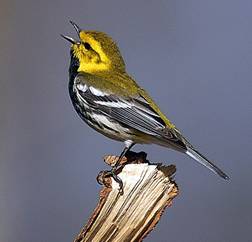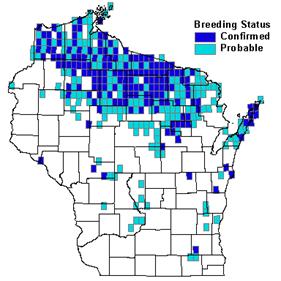Photo by Dennis Malueg


Status/Protection
- Global Rank: G5 Key to global and state ranks
- State Rank: S4B
- WBCI Priority: PIF
Population Information
The Federal BBS information can be obtained at http://www.mbr-pwrc.usgs.gov/bbs/bbs.html by clicking on Trend Estimates and selecting the species in question. All estimates are for time period (1966-2005).
*Note: There are important deficiencies with these data. These results may be compromised by small sample size, low relative abundance on survey route, imprecise trends, and/or missing data. Caution should be used when evaluating this trend.
- Federal Breeding Bird Survey: non-significant increase
- Federal Breeding Bird Survey (WI): non-significant increase
- Federal Breeding Bird Survey (BCR 23): significant increase*
- Federal Breeding Bird Survey (BCR 12): non-significant increase
- Chequamegon National Forest Bird Survey (NRRI): significant decline (1992-2005)
- WSO Checklist Project: significantly increasing (1983-2007)
Life History
- Breeding Range: Eastern British Columbia east across southern Canada and the northeastern U.S. to Atlantic Coast, extending south into Appalachian Mountains (Morse 1993).
- Breeding Habitat: Northern Hardwood, Hemlock Hardwood, Fir-Spruce, White Pine.
- Nest: cup, usually 1-3 meters (3-10 feet) above ground, occasionally higher. Usually in a conifer (Ehrlich et al. 1988, Morse 1993).
- Nesting Dates: early June – late June in WI (WSO 1995); as early as May in Appalachians (Morse 1993).
- Foraging: foliage gleans, hawks, hover glean, bark glean (Ehrlich et al. 1988).
- Migrant Status: Neotropical Migrant.
- Habitat use during Migration: higher elevation forests, forest edge, some use of shrubby secondary woodland, trees in pastures (Morse 1993).
- Arrival Dates: early – late May (Robbins 1991).
- Departure Dates: mid August – mid October (Robbins 1991).
- Winter Range: Mexico, Central America, Columbia, Venezuela, West Indies (DeGraaf and Rappole 1995).
- Winter Habitat: canopy of oak and pine forests, elfin oak forest, in acacias in fields; occurs from 600-3000 meters in elevation (Morse 1993).
Habitat Selection
The Black-throated Green Warbler is found nesting in boreal and mixed northern forests in a wide variety of forest habitat types (Robbins 1991). It likely reaches its highest abundance in older mixed northern hardwood-hemlock stands. Nests are placed in conifers at the point where two branches emerge from the trunk of a tree. The majority of nests are within 1-3 (3-10 feet) meters above ground, but this species sometimes nests as high as 20 meters (65 feet) above ground (Morse 1993).
This species is segregated by sex in terms of habitat preference on the wintering grounds in Mexico (Lopez Ornat and Greenberg 1990) .
Habitat Availability
The Black-throated Green Warbler chooses a variety of forest habitats in WI, being found in white cedar swamps (Hoffman and Mossman 1993), extensive northern alder thickets with associated swamp conifers (Hoffman 1989b), boreal forests (Mossman et al. 1990), pine forests (Hoffman and Mossman 1990), and northern mesic forests (Hoffman 1989a). Most northern forest types in WI therefore have this species present, and it is considered a “source/core” species (Howe et al. 1992), with individuals from WI sustaining global populations by providing surplus individuals that move to other geographic areas.
Population Concerns
This species has shown periodic declines in some areas of its range (WI and MI), while other areas (northern MN, for example) have shown stable populations (Morse 1993). However; recent data suggests that BTNW are increasing in WI. Year-to-year variation in numbers is noticeable, perhaps in response to unfavorable weather conditions in some breeding seasons. Blake et al. (1992) studied response of this species to drought, and hypothesized that drought may be responsible for periodic declines in WI. Numerous studies show this species is sensitive to forest fragmentation (Askins 2000, Rappole 1995). This species will disappear from areas after intensive even-aged logging of both coniferous and deciduous forests, especially if remaining forest stands are isolated. The Black-throated Green Warbler declines sharply after the application of pesticides to control for spruce-budworm infestations. The BTNW is negatively impacted by forest cutting on the wintering grounds, but it will use canopy tree species in coffee plantations. Because of its large winter range, it may not be as susceptible to localized forest removal in the tropics as some other passerines (Chequamegon NF Bird Survey (NRRI) species account http://oden.nrri.umn.edu/mnbirds/speciesaccounts.htm, Morse 1993).
Partners in Flight categorizes this species as a continental stewardship and regional stewardship species for Wisconsin. Wisconsin and the other Western Great Lakes states have a long-term planning responsibility to ensure continued healthy source populations across the region.
Recommended Management
Pearson and Niemi (2000) determined that management of forests for these species requires the maintenance of conifer components within the forests of northern MN, and we have every reason to expect the same is true for northern WI. They state that conifer stands may support “source populations” of these species, from which some individuals may then move into nearby deciduous forest habitats. This indicates a need for “landscape-level” management, protecting both deciduous and coniferous forest habitats, to provide for a diversity of species (Pearson and Niemi 2000). Howe et al. (1992) described BTNW as a “source/core” species, which is in agreement with Pearson and Niemi’s recommendations. BTNW was one species in a study by Darveau et al.(1995) that was present in 60-meter-wide riparian strips left after logging, but not in 20- meter-wide strips. Morrison et al. (1998) suggest this may mean wider riparian strips provided after logging may provide a good riparian buffer width for conservation of forest birds, but the authors mention that data are needed on demographics of these species (BTNW, Swainson’s Thrush, Golden-crowned Kinglet) after this type of forest treatment. In general, uneven-aged management of mesic forest types that promote conifer retention should benefit this species.
Research Needs
Continued research into population regulation of this and other Neotropical migrants is needed. A complicated set of factors (incl. deforestation on both breeding and wintering grounds, long-term effects of pesticides on populations, effects of habitat fragmentation on breeding grounds, aftereffects of extreme weather events) may variably affect numbers across the geographic range of the Black-throated Green Warbler and its congeners (Morse 1993).
Information Sources
- Wisconsin Breeding Bird Atlas http://www.uwgb.edu/birds/wbba/
- NRRI website http://oden.nrri.umn.edu/mnbirds/newaccounts/BTNWa2.htm
- Great Lakes Bird Conservation probability map http://www.uwgb.edu/birds/greatlakes/species/btnwmap2.htm
- Nicolet National Forest Bird Survey population trend http://www.uwgb.edu/birds/nnf/trends/BTGW.htm
- Nicolet NF bird survey species map http://www.uwgb.edu/birds/nnf/species/BTNW.htm
- Nicolet NF bird survey habitat/species group map http://www.uwgb.edu/birds/nnf/mdufbirds.htm
References
- Askins, R. A. 2000. Restoring North America’s birds: lessons from landscape ecology. Yale Univ. Press, New Haven, CN.
- Blake, J. G., G. J. Niemi, and J. M. Hanowski. 1992. Drought and annual variation in bird populations: Effects of migratory strategy and breeding habitat. In Ecology and conservation of neotropical migrant landbirds, J. M. III Hagan and D. W. Johnston, eds, 419-29. Washington, DC: Smithsonian Institution Press.
- Darveau, M., P. Beauchesne, L. Belanger, J. Huot, and P. Larue. 1995. Riparian forest strips as habitat for breeding birds in boreal forest. J. Wildl. Manage. 59(1): 67-78.
- DeGraaf, R.M., and J.H. Rappole. 1995. Neotropical migratory birds: natural history, distribution, and population change. Comstock Publ. Assoc., Cornell Univ. Press, Ithaca, NY.
- Ehrlich, P.R., D.S. Dobkin, and D. Wheye. 1988.The birders handbook: a field guide to the natural history of North American birds. Simon & Schuster, Inc. New York.
- Hoffman. R.M. 1989a. Birds of Wisconsin northern mesic forests. Pass. Pigeon 51(1): 97-110.
- Hoffman, R.M. 1989b. Birds of tall shrub communities: alder thickets and shrub-carr. Pass. Pigeon 51(3): 263-273.
- Hoffman, R.M., and M.J. Mossman, 1990. Birds of northern Wisconsin pine forests. Pass. Pigeon 52(4): 339-356.
- Hoffman, R.M., and M.J. Mossman. 1993. Birds of Wisconsin’s northern swamps and bogs. Pass. Pigeon 55(2): 113-137.
- Lopez Ornat, A., and R. Greenberg. 1990. Sexual segregation by habitat in migratory warblers in Quintana Roo, Mexico. Auk 107: 539-543.
- Morse, D. H. 1993. Black-throated Green Warbler (Dendroica virens). In The Birds of North America, No. 55. Philadelphia: The Academy of Natural Sciences, and Washington, D.C.: The American Ornithologists’ Union.
- Howe, R.W., M.J. Mossman, and S.A. Temple. 1992. Effects of natural forest management on birds in northern Wisconsin. Pass. Pigeon 54 (4) 297-306.
- Morrison, M.L., B.G. Marcot, and R.W. Mannan. 1998. Wildlife-habitat relationships: concepts and applications. Univ. of Wisconsin Press, Madison.
- Mossman, M.J., E. Epstein, and R.M. Hoffman, 1990. Birds of Wisconsin boreal forests. Pass. Pigeon 52(2): 153-168.
- Pearson, C., and G. Niemi. 2000. Effects of within-stand habitat and landscape patterns on avian distribution and abundance in northern Minnesota. Proceedings of IBFRA Assn. 1997 meeting. In S.G. Conrad, Ed. “Disturbance in boreal forest ecosystems: human impacts and natural processes”. International Boreal Forest Research Association. USDA Forest Service, North Central Research Station, GTR NC-209.
- Rappole, J.H. 1995. The ecology of migrant birds. Smithsonian Institution Press, Washington, D.C.
- Robbins, S. D. 1991. Wisconsin birdlife: population & distribution, past & present. Univ. of Wisconsin Press, Madison, WI.
- Wisconsin Society for Ornithology. 1995. Wisconsin breeding bird atlas; atlasing handbook 1995-1999. Wisconsin Society for Ornithology, Inc., Hartland, WI.
Contact Information
- Compiler: William P. Mueller, 414-643-7279, iltlawas@earthlink.net
- Editor: Jim Baughman, 715-479-8870, james.baughman@dnr.state.wi.us
